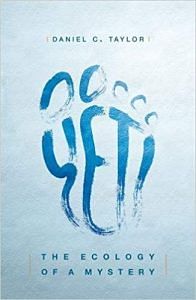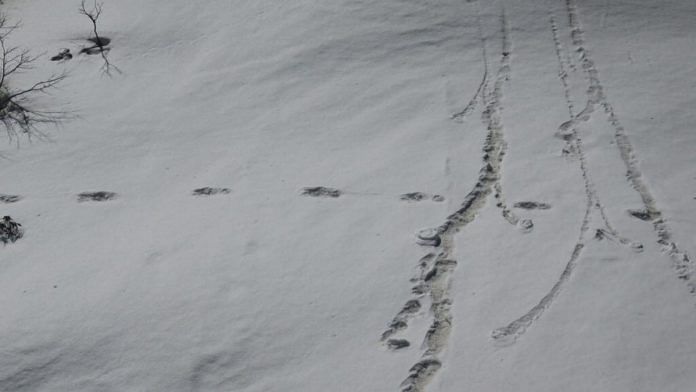As I went on my footprint expeditions, one question I’ve wondered over the years is: what would be done with a Yeti if I found it? I might try directing the action, but certainly I would lose control. Would my Yeti be welcomed as a member of society, a hominoid, or put into a zoo as an animal? Or, if only one individual was ever found, would it be pickled and put into a museum? Though I carried on with my search, I often asked myself whether I really wanted to find a live Yeti.
…
Nick returns from Nepal a week later. From the tone of his voice on the phone call it’s clear he has more to share than memories of a month in the jungle. He knows nothing of the Smithsonian skulls, of arboreus, or the slides.
Minutes after entering the house, he’s talking. ‘The prints I found in the Langtang Valley were like those we saw on the ridge—thumb-like marks too. In Tarkegaon, I found the skin of a black bear about the size of the zoo bear. The man who owned the skin had killed the bear, so I questioned him. On his own, he used the words ‘rukh balu’. Yes, rukh balu. The surprising thing is villagers also claim the presence of a large bear, bhui balu! Another villager showed me the skin of a ground bear. I took pictures of everything.’
Do two bears exist not just in the Barun but across the eastern Himalaya? In how many valleys? Is Nick’s Nepali good enough for his reports to be trustworthy? Two months later, a letter arrives from Bob: ‘Since we were together in February, on three treks I picked up village reports of tree and ground bears: the southern slopes of Himalchuli, Rowaling Valley, and Sikkim.’
As I had been trying to put the pieces together, I’ve written to Cronin twice asking if he and McNeely had found two bears, but he hasn’t replied, and I’ve called his phone. I’ve also sent letters to McNeely in Switzerland, but there is no answer from him too—did they find reports about tree and ground bears?
Working from field notes, I pull together the known fragments.
- Reports of the tree bear come now from the Barun and four regions (Fleming found three of these). These reports cut across ethnic groups that have little contact with each other; yet, despite their cultural differences, tree- and ground-bear descriptions are consistent.
- A small bear lives (and has lived for two years in the Kathmandu zoo) and has not grown. It fits the description of tree bears. Of particular interest about this zoo bear is a dropped inner digit on its front paws.
- We possess an apparently mature skull and two paws from another such small bear; this bear being Lhakpa’s Barun bear.
- In 1869, Oldham reported the existence of a similar bear in Darjeeling, sixty-five air miles from the Barun Valley, and called it arboreus.
- Nick photographed the skin of another such tree bear in the Helambu Valley and saw the skin of a larger bear alleged to be a ground bear.
- The photographs we took in the Barun indicate that this tree bear makes tracks that are primate-like. It seems to have a hallux and the ability to walk bipedally, thus fitting the Yeti stories—yet we know the prints have been made by a bear.
- Nail marks and hair suggest this bear (the hair sample collected from the nest matches Selanarctos hair in the Smithsonian) is dexterous at climbing trees and makes nests breaking bamboo one-inch in diameter at uniform heights. It also seems to make nests in oaks, and this suggests superb tree-climbing ability.
- Some of the aforementioned traits are reported for Selanarctos but not all. But it needs be noted that Selanarctos has never been described scientifically. Most Selanarctos evidence has come from hunters before World War II. The Russian evidence, not yet studied, appears to be more scientific.
Is the tree bear a subspecies of Selanarctos? Are there genetic differences not visible in the skulls? Are tree and ground bears the same? Might tree bears be female and ground bears male? Or, could the tree bears be juveniles and ground bears adults? Also, could tree bears be runts and ground bears normal? What is particularly puzzling about the Cronin or McNeely evidence is their descriptions of aggressive bear behaviour (Cronin spent half-an-hour telling me on the phone and told the same to Fleming). Those reports indicate ground bears. How could Cronin or McNeely spend two years in these jungles and never discover nests? That they missed the tree bear may not be that surprising; I missed it too, and we found it only when we knew what to ask. It seems incredible that a bear should remain scientifically undetected. But maybe it is not.
The era when scientists were looking for new animals ended in the mid-twentieth century; Nepal was closed then.
 This excerpt from YETI: The Ecology of a Mystery by Daniel C. Taylor has been published with permission from Oxford University Press.
This excerpt from YETI: The Ecology of a Mystery by Daniel C. Taylor has been published with permission from Oxford University Press.



